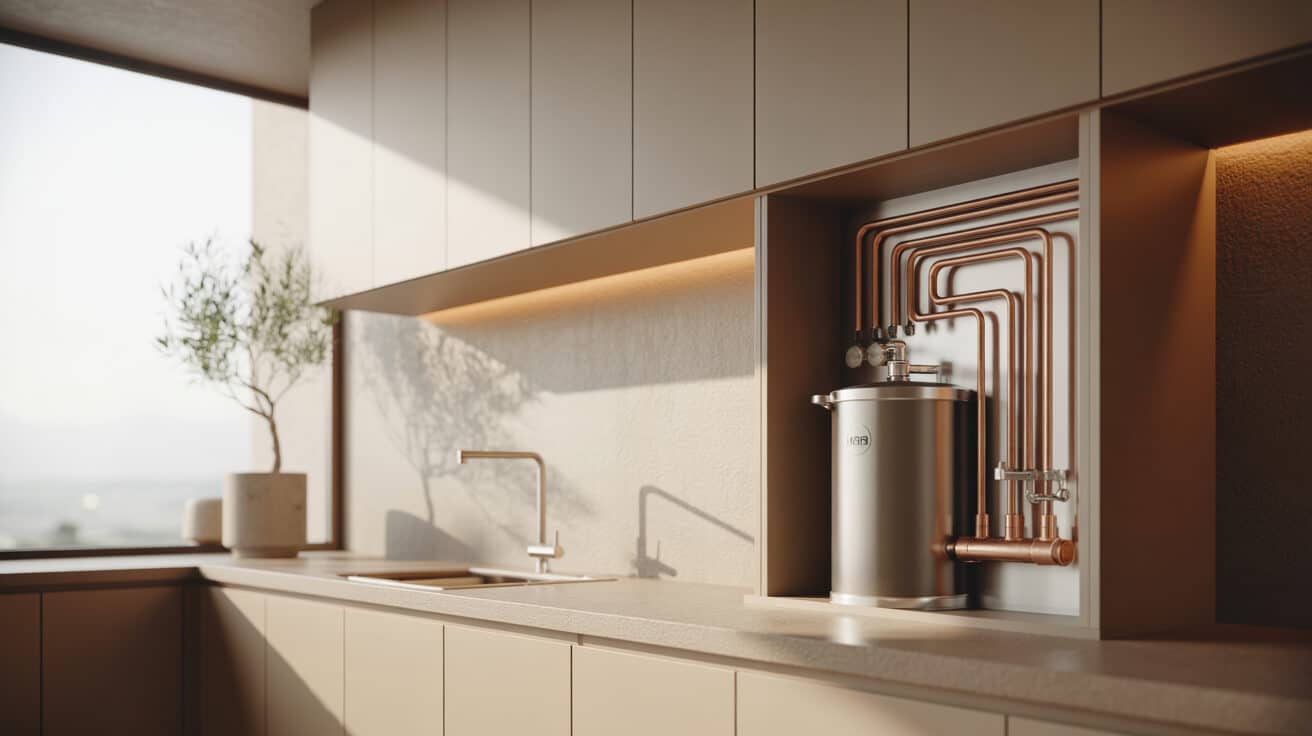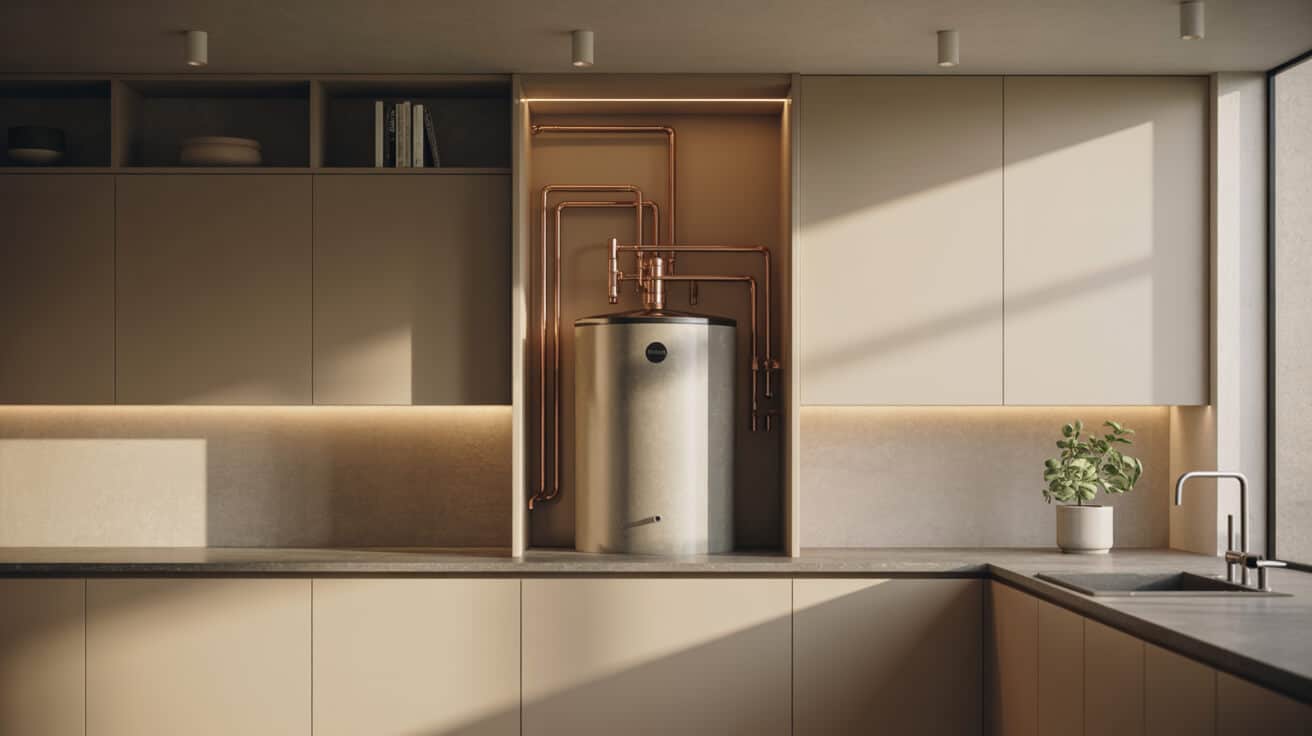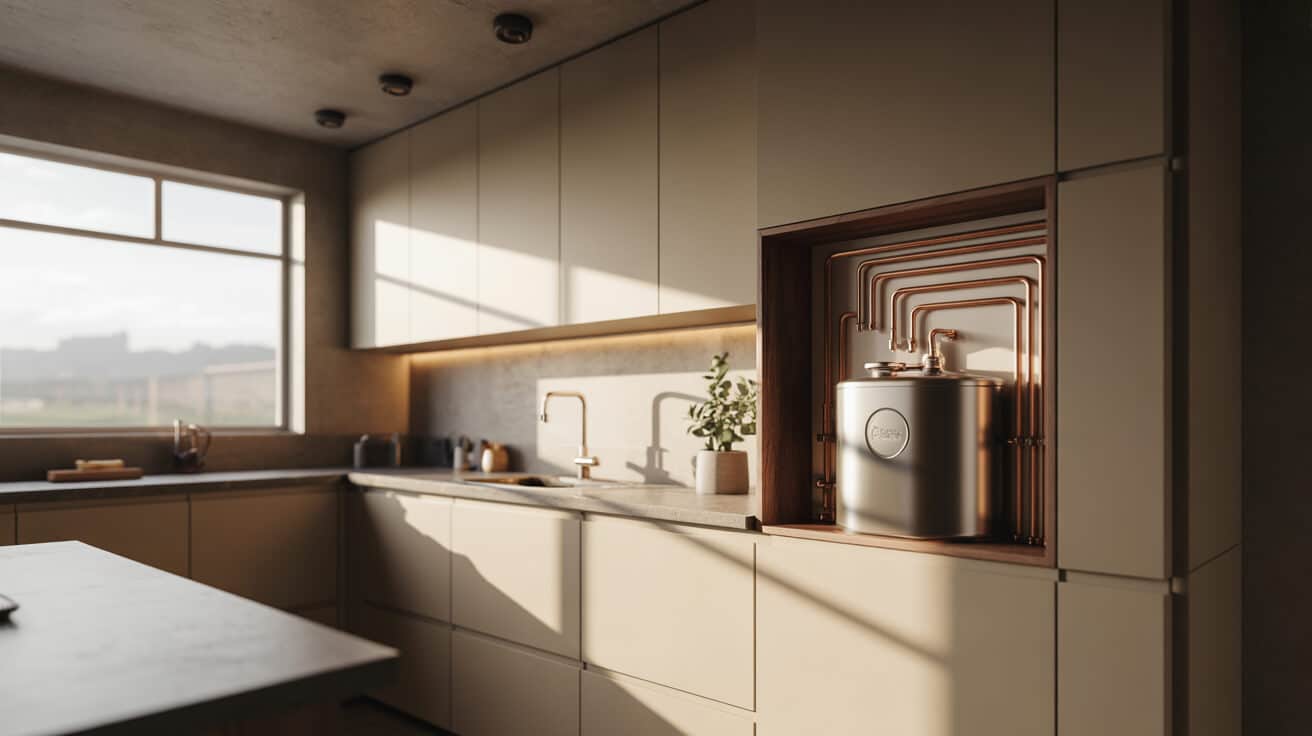Thermal store systems occupy a strategic position within contemporary building services, serving properties that need exceptional reliability, flexible energy integration, and minimal compliance overhead. Whether installed in homes, flats, social housing, or commercial premises, a thermal store functions as a centralised energy buffer—accepting heat from sources as diverse as conventional boilers, solar thermal panels, heat pumps, and solid-fuel stoves. The system’s core advantage is its support for safe, regulated, and consistent hot water delivery at usable pressure, whilst simultaneously enabling property owners, managers, and users to optimise efficiency and adapt to evolving regulatory standards. When partnered with experienced firms such as Plumbers 4U, installation and operation become manageable even for non-specialists, extending these benefits to households and businesses alike.
Etymology or name origin
The term “thermal store” derives from late-twentieth-century mechanical engineering, referencing a vessel or appliance dedicated to the storage and management of thermal energy in water. Related concepts include heat accumulator (emphasising storage for later use), buffer tank (highlighting central heating functions), and heat battery (used for devices capable of charging/discharging energy). Within the United Kingdom and internationally, standard terminology reflects technical evolution: “thermal store” emphasises stratification and separation, while “accumulator” or “buffer” may denote a broader range of heating storage or pressure systems. Differences in regulatory classification and installer language add further complexity, yet the underlying principle of storing and managing heat energy remains common.
Overview / context
General Principle
A thermal store operates by receiving, storing, and supplying heat energy as needed by your building. Stratification allows the tank to contain hot water at varying temperatures within different layers, so the hottest water is drawn from the top for domestic use, while lower-temperature layers serve central heating or permit staged heat input. Unlike vented cylinders (which rely on gravity feed from tanks in a loft) or unvented cylinders (which store water under pressure for distribution), a thermal store maintains separation between the water it stores and the potable water supplied to outlets, often transmitting heat through coiled heat exchangers or external plate exchangers.
Placement within Plumbing & Heating
Thermal stores represent the point of intersection between legacy systems and future-focused solutions. They support legacy boilers and new technologies alike, offering an option to blend these capabilities. For homeowners, landlords, and facilities managers, the system’s principal value lies in its ability to maintain hot water and heating service even as regulations, sources, and property needs change—de-risking investments through its adaptability.
Adoption in Practice
Thermal stores have found roles in a range of contexts:
- Residential buildings where existing infrastructure inhibits unvented installation.
- Properties seeking integration with heat pumps, solar thermal, or biomass.
- Social housing and multi-unit developments requiring simplified compliance and risk reduction for landlords and block managers.
- Commercial and institutional sites needing centralised, robust, and future-ready heating solutions.
History
Origins and Early Development
The concept of retaining hot water in storage vessels dates back millennia: ancient Roman public baths and simple Victorian-era copper tanks both illustrate a basic approach to batch heating and storage. With the gradual spread of piped systems in nineteenth-century cities, gravity-fed and later pressurised cylinders became commonplace—serving both bathing and increasingly, central heating.
Industrial Emergence
By the mid-twentieth century, the rising prevalence of central heating in the United Kingdom and elsewhere created demand for solutions to integrate boilers with variable hot water demand. Buffer tanks and accumulator vessels emerged as answers—acting both as stores and regulators of thermal output. The thermal store refined this approach by emphasising chemical and hydraulic separation, stratification for efficiency, and an ability to harness multiple heat sources.
Contemporary Trends and Innovations
Recent decades have seen pronounced growth in the use of thermal store systems. Skyrocketing energy prices, electrification policies, and enhanced building regulations have accelerated their adoption. Interest in carbon reduction policies has propelled the design toward compatibility with solar and heat pump technologies. Modern digital controls and improved insulation now allow for smart, highly efficient operation. Companies such as Plumbers 4U have contributed to public and private adoption through comprehensive installation services and consultancy, enabling property owners and operators to meet new standards with confidence.

Concept / description
Physical Structure
A standard thermal store comprises a vertically oriented cylinder, generally manufactured in stainless steel or glass-lined steel, with volumes ranging from 120 to over 500 litres depending on application. The tank is coated with high-specification insulation (such as polyurethane foam) to minimise standing losses. Its interior is designed for stratification, with minimal mixing, allowing hot water to be available for immediate use at the uppermost draw-off. Externally or internally mounted heat exchangers transfer energy from one or more sources—boilers, solar coils, or immersion heaters—while separate plate heat exchangers deliver potable hot water on demand.
Key Mechanisms and Operation
The primary feature of a thermal store is separation: the water stored internally is not consumed at outlets but instead heats the supply via heat exchangers. This protects your taps, showers, and appliances from contamination by primary circuit water, a feature of paramount importance in multi-residential and institutional settings.
Water stratifies naturally: as energy is added, the hottest water accumulates at the top, with each subsequent layer progressively cooler. smart controls and sensor arrays track these temperature bands, activating pumps or isolating heating inputs as necessary. Blending valves prevent risks of scalding and ensure all outlets deliver water within safe limits. Expansion is managed through either open-vented or sealed arrangements, suited to your property’s requirements.
Core Components
- Insulated Tank: Core storage volume, thickness and material affecting efficiency and durability.
- Heat Exchangers: Internal coils (for boilers, heat pumps, solar) and external plate exchangers (for delivering hot water at pressure).
- Safety & Control Devices: Temperature sensors, thermostats, blending valves, expansion vessels, and compliance features (such as visible discharge pipes).
- Back-up Heater or Immersion: Electric elements providing resilience during main source outage or for scheduled heating cycles.
Functionality / purpose / applications
Stable Hot Water and Heating Service
Through stratified storage, a thermal store can deliver hot water at constant pressure and temperature, regardless of fluctuations in heat input. Your household or business benefits from demand balancing: heat can be collected during cheaper tariff periods or peak renewable generation, then deployed as demand fluctuates.
Multi-Energy Integration
Thermal stores accommodate boilers (gas, oil, biomass), electric immersion heaters, solar thermal panels, and air or ground source heat pumps. Their design enables property managers—without comprehensive technical expertise—to blend traditional and renewable systems within the same infrastructure. This makes future upgrades less disruptive and allows path-dependent compliance with energy regulations.
Safety, Compliance, and Property Value
As the stored water does not enter the potable supply, stores sidestep certain regulatory demands, particularly the UK G3 requirement covering unvented systems. Blending valves and thermostatic controls offer additional layers of risk-reduction by preventing scalding and maintaining hygiene standards, with periodic temperature cycles to minimise the chance of Legionella. Property owners thus see both compliance simplification and improved asset valuation—a benefit further amplified with WRAS-approved installations by firms such as Plumbers 4U.
Classifications / types / variants
By Connection Type
- Open-vented Systems: Linked to a header tank, these offer atmospheric operation with simple components; ideal where compliance simplicity and leak risk management matter.
- Sealed/Pressurised Systems: Integrate with pressure-regulated expansion vessels; used where property layout precludes header tanks, such as apartments or flats.
- Hybrid Arrangements: Employ characteristics of both types, particularly where legacy systems must be integrated.
By Energy Integration
- Direct Thermal Stores: The heat source (e.g. solid-fuel stove) heats primary water directly, which is then used for heating or transferred to the plate exchanger for hot water.
- Indirect/Multi-coil Stores: Use one or more heat exchangers, each dedicated to boilers, solar, or heat pumps, thus keeping sources isolated and maximising stratification.
- Twin-coil and Multi-coil: Allow successive or simultaneous input from multiple sources to maximise renewable content.
By Control and Automation
- Basic Mechanical: Use manual thermostats, timeclocks, and minimal automation—suitable for traditional domestic applications.
- Digital/Smart: Incorporate programmable logic, wireless or wired remote monitoring, and can interface with building management systems or tenant apps for usage tracking.
Systems / tools / methodologies
Installation Process
Professional installation typically proceeds through detailed pre-survey, mains supply and system sizing, compliance checklists (particularly for WRAS and Water Regulations), and staged commissioning.
| Step | Toolset/Methodology | Rationale |
|---|---|---|
| Property Evaluation | Building survey, usage modelling | Ensures proper storage and flow |
| Cylinder Placement | Lifting aids, anchors, safety gear | Prevents leaks, meets standards |
| Circuit Integration | Pipe wrenches, press-fit tools | Clean, secure hydraulic connect. |
| Water Quality Control | Chemical dosing, philtre equipment | Prevents scaling/sludge/failure |
| Testing/Commissioning | Multimeter, thermometer, pressure testers | Functional and regulatory check |
| Documentation | Digital asset logbook, certification forms | Ensures future service, warranty |
Annual system service and periodic diagnostics (such as scale removal or pump check) further extend system life and maintain compliance.
Sizing and Survey Methodology
Installer professions use daily hot water demand, occupancy, property insulation level, peak load simulation, and consideration of future upgrades (e.g., addition of solar panels) in their calculations. Preferred tools include manufacturer-provided calculators, industry best-practice tables, or customizable engineering spreadsheets. Organisations like Plumbers 4U often augment these models with on-site experience and proprietary service data.

Stakeholders / entities involved
Internal Roles
- Heating Engineers and Plumbers: System selection, installation, annual service, and troubleshooting.
- Service Managers/Commissioning Agents: Supervise multi-property installations, quality assurance, and compliance tracking.
External and Regulatory Entities
- Building Control Officers: Review plans, ensure compliance with safety codes and water regulations.
- Manufacturers: Provide certified components, installation manuals, and warranties.
- Compliance Consultants: Help organisations navigate evolving regulatory requirements, particularly in social or public-sector housing.
- Facility Managers, Landlords, End-users: Responsible for ongoing care, user education, safety, and operational oversight.
Customer Journey
Your company, as an asset owner, tenant, or landlord, relies on trained professionals and approved suppliers for uninterrupted service, cost-effective maintenance, and future-proofed compliance.
Legal / regulatory / ethical considerations
Regulatory Framework
- Building Regulations Part G (Sanitation, Hot Water Safety): Specifies maximum safe water temperatures, anti-scald precautions, and installation requirements.
- Part L (Conservation of Fuel and Power): Enforces minimum insulation standards and energy-saving components.
- WRAS Certification: Mandates use of approved materials in all potable water contact points.
- Legionella Risk Management: Stipulates operational temperatures above 60°C, regular purging, and anti-scald blend valves.
- G3 Certification (Unvented Cylinders): Generally not required for open-vented thermal stores, simplifying compliance, particularly for landlords and non-specialist managers.
Installer and Warranty Requirements
All installation, servicing, and maintenance must be undertaken by certified professionals, ideally with WRAS, G3, or equivalent qualifications. Work should be documented in line with asset management best practices, including digital logbooks. Our services at Plumbers 4U follow these requirements closely, ensuring full warranty protection and legal compliance for your organisation.
Health, Safety, and Ethics
Regular inspection regimes—annual or as directed by risk assessment—are needed to safeguard users. For buildings with vulnerable occupants (elderly, children, tenants in social care), anti-scald, hygiene, and backup heating provisions are legally and ethically mandatory.
Performance metrics / data / measurements
Heat and Water Efficiency
Key performance metrics for a thermal store include:
- Standing Heat Loss: (W/24h): Measures insulation quality and cost-of-operation.
- Hot Water Flow Rate: (L/min): Assures delivery to multiple outlets at required pressure.
- Recovery Time: (Minutes): How quickly the system can replenish after depletion.
- Buffer Volume Effectiveness: Optimises peak usage and stores surplus heat.
| Metric | Typical Range | Influencing Factor |
|---|---|---|
| Standing Heat Loss | <2–3 kWh/24h | Cylinder insulation (mm), siting |
| Hot Water Flow Rate | 12–30 L/min | Plate exchanger, mains supply |
| Recovery Time | 20–60 min | Heat source power, sizing |
| Buffer Volume Eff. | 80–95% | Stratification, control strategy |
Energy performance, maintenance intervals, and lifecycle cost depend on correct initial sizing, periodic service, and parts selection. Properties or businesses working with reputable companies see more stable running costs and reduced risk of sudden failure.
Challenges / barriers / limitations
Technical and Operational Barriers
- Airlocks and Flow Disruption: May occur after installation or service unless purging is correctly performed.
- Scale & Sludge Accumulation: Hard or chemically imbalanced water can create limescale within exchangers and tanks, impeding efficiency.
- Pump and Valve Wear: Recurrent cycling or poor-quality parts can result in decreased service lifespan.
- User Education: Confusion around control settings or maintenance obligations is a frequent complaint among new users or in multi-tenant environments.
Social and Economic Factors
- Installation Outlay: Thermal stores are often more expensive upfront than traditional cylinders.
- Space Requirement: Tanks may demand more room than modern combis or instantaneous heaters.
- Policy Uncertainty: Ongoing regulatory evolution and energy market fluctuation affect system cost-benefit analysis, especially for landlords or portfolio managers.
Future Planning
The increasing complexity of building services means a careful approach to system upgrades is mandatory, with comprehensive lifecycle planning at the procurement, installation, and maintenance stages.
Impact / influence / legacy
Thermal stores have catalysed a shift in the plumbing and heating sector toward integrated, flexible, and future-ready systems. Their modular nature and compliance clarity have helped landlords and facilities managers cut through regulatory complexity, especially when managing large or distributed property assets. Property owners report fewer emergencies, less downtime, and steadier operating costs when utilising this approach, especially when supported by companies like Plumbers 4U that provide full-cycle service.
Within the broader market, the method underpins ongoing professional development for plumbers and engineers, advances supply chain standards, and continues to influence regional and national energy strategies. Building services curricula and upskilling programmes now emphasise controls integration, legal competence, and multi-energy support—the very skills thermal store instal and maintenance cultivate.
Future directions, cultural relevance, and design discourse
Innovations and Perspectives
The next phase of development centres on:
- Enhanced stratification management, using predictive controls and adaptive sensor arrays.
- Algorithmic integration to prioritise renewable energy intake relative to occupancy or tariff.
- Modular expansion for phased or incremental upgrades, dovetailing with new developments and retrofits.
Policy, Cultural and Social Context
Rising energy security concerns underscore the value of a thermal store’s energy buffering and flexibility. National programmes to decarbonize heat will shape design choices, driving accelerated adoption of hybrid and renewable-compatible systems.
Evolving Industry Discourse
Discussion within the plumbing and heating sector now focuses on leveraging smart platforms, digital documentation, and interoperable controls to elevate asset value and streamline compliance. As expectations evolve, users and asset owners increasingly regard thermal stores as a mark of forward-thinking, low-risk investment—hallmarks reinforced through expert guidance and service provided by established professionals.

